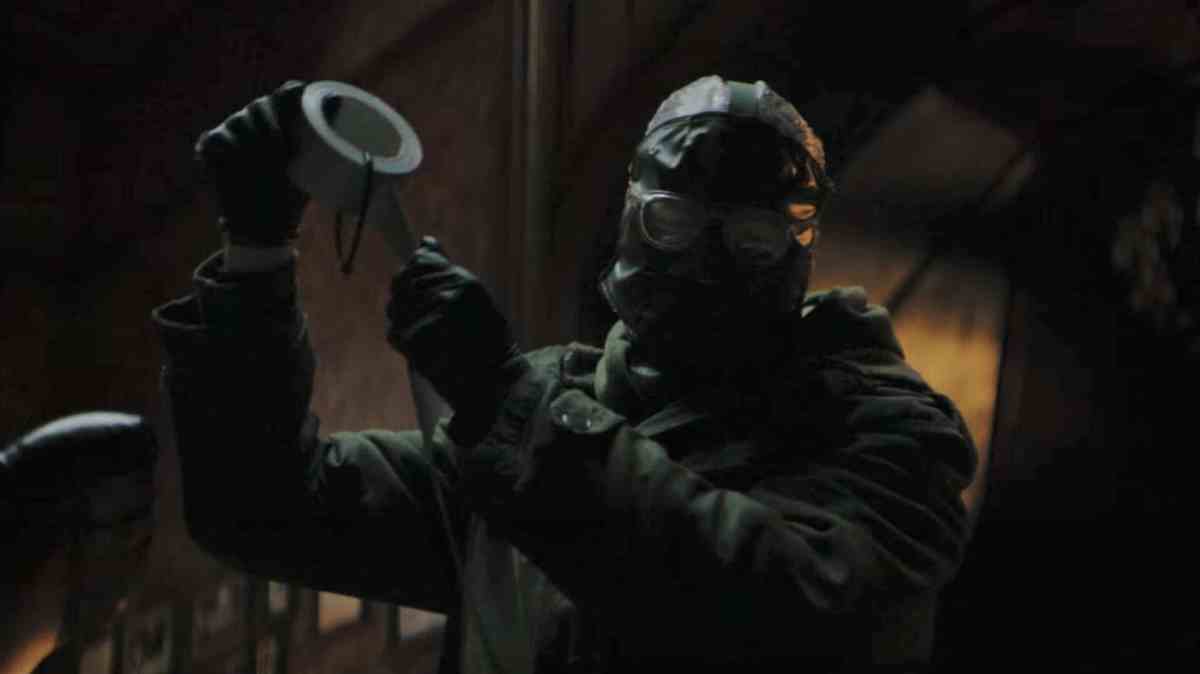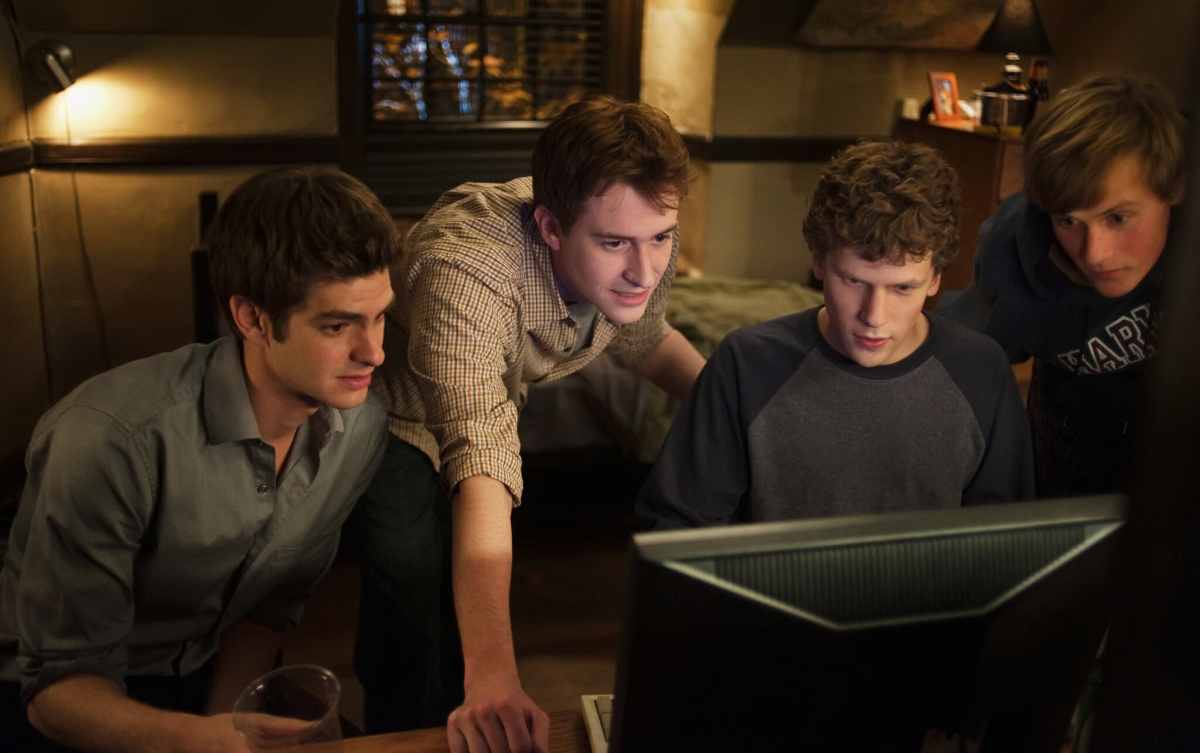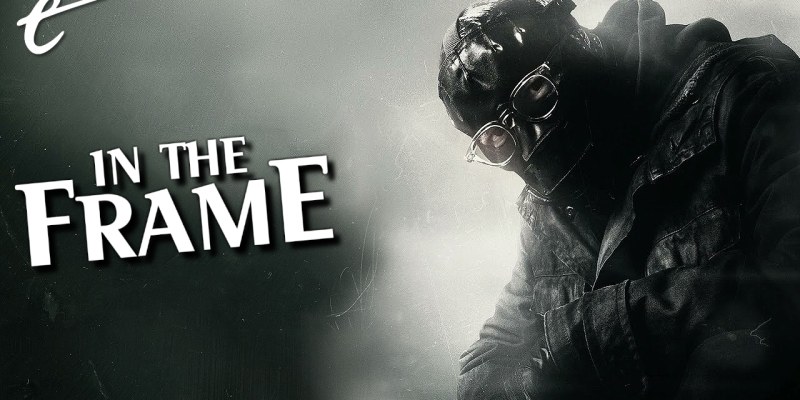This article contains spoilers for The Batman, as well as the David Fincher films Fight Club and, uh, The Social Network.
One of the more interesting structural elements of The Batman is the fact that Batman (Robert Pattinson) and the Riddler (Paul Dano) never find themselves sharing the same physical space.
The closest that they come is probably briefly during the memorial service for Mayor Don Mitchell Jr. (Rupert Penry-Jones). Batman attends the ceremony as Bruce Wayne, convinced that the Riddler will likely show up to insert himself into the narrative. This seems to be the case. As a car plows into the service and the mourners scatter, Bruce notices a figure remaining alone on the upper balcony. The figure is only visible in silhouette, and there is no way for Bruce to reach him.
Over the rest of the movie, Batman and the Riddler find themselves separated by screens of one sort or another. The Riddler broadcasts a message to Gotham after the murder of Police Commissioner Pete Savage (Alex Ferns). He chats to Batman via video call during a bomb scare involving District Attorney Gil Colson (Peter Sarsgaard). The two text-message each other through a remote internet address that the Riddler embeds in one of his puzzles.
Even when the police take the Riddler into custody towards the climax of the film, the two characters remain curiously separate from one another. As the cops handcuff the Riddler inside a diner, Batman watches from outside through the window. When the Riddler summons Batman to Arkham, the two talk through a glass divider. The two are able to communicate and engage with one another, but they never truly share the same environment.

It’s a bold choice, particularly for a genre built around catharsis through violent spectacle. The Batman aggressively denies its audience the emotional release of a direct confrontation between hero and villain. The movie is enriched by this. It allows co-writer and director Matt Reeves the opportunity to interrogate the superhero genre, asking what it is about beyond watching people punch each other. It also neatly ties back into the movie’s themes of paranoia and voyeurism.
There is more to it. This emphasis on the physical separation between Batman and the Riddler is part of what marks The Batman as a thoroughly modern movie. In many respects, The Batman can be seen as a throwback to the New Hollywood movement of the 1970s, evoking classics like The Conversation, Klute, Chinatown, and The Godfather. However, beneath this classicism, The Batman is a much more modern film than many of its superhero contemporaries.
The influence of David Fincher is keenly felt on The Batman. This was obvious from the first trailers, which evoked Fincher’s serial killer classic Se7en. Unsurprisingly, Fincher’s work on Zodiac has also come up in discussions of the movie, not least because of the film’s use of deliberate ambiguity and the Riddler’s costuming. It is hard to escape these parallels. The Riddler evokes John Doe (Kevin Spacey), the insane serial killer from Se7en who treats murder as performance art to make a point.
However, Fincher’s influence on The Batman runs considerably deeper than this. Beneath these surface references, it is also possible to detect traces of Fight Club in the movie’s portrayal of its angry and violent male outrage. The violence in The Batman is frequently gendered, particularly with Carmine Falcone’s (John Turturro) strangulation of Maria Kyle, Selina Kyle (Zoë Kravitz), and Annika Koslov (Hana Hrzic). The Riddler’s followers are effectively his own twist on Project Mayhem.

Fight Club was massively controversial when it was released in 1999. It remained divisive in the years that followed, particularly given the film’s embrace by certain misogynistic corners of the internet. Shortly before the release of The Batman, Fight Club was still generating headlines, with the movie censored by Chinese authorities to offer a less ambiguous and more uplifting closing message. The movie continues to spark heated discussion to this day.
In some ways, The Batman evokes Fight Club. In The Batman, lonely and lost billionaire Bruce Wayne has created an alternate persona known as the Batman to venture out into the night and provide structure to his existence. In Fight Club, the anonymous narrator (Edward Norton) manifests the fantastical ideal Tyler Durden (Brad Pitt) to inject a little excitement into an otherwise empty life. Both the Batman and Durden define themselves through violence, with Tyler launching Fight Club.
Tyler also recalls the Riddler, in his angry rhetoric about a broken system that has disenfranchised an entire generation. Tyler steers the Fight Club away from simple violence towards a more aggressive attack on the failed institutions that have left these men feeling so adrift. In some ways, Fight Club was ahead of its time, predicting the radicalization of young men through this sense of spiritual ennui. The Riddler does something similar, inspiring his own followers to attempt mass murder.
In Fight Club, the narrator’s creation of Durden is implicitly tied to a chance encounter with Marla Singer (Helena Bonham Carter). Marla challenges the narrator. She stirs feelings in him. It’s possible to read the entire film as a breakdown inspired by the narrator’s inability to process his emotional connection to this woman. Ultimately, it is only through navigating his feelings towards Marla that the narrator is able to escape from the self-destructive clutches of his angry alternate self.

There is similar subtext in The Batman. Much has been made of how The Batman is horny, a rarity in the age of sexless blockbusters. However, Batman’s relationship to Selina is challenging for him. In their first encounter, they wrestle in a manner that is heavily sexual. When she betrays him to steal money from Falcone, he responds by viciously slut-shaming her. Pattinson’s performance is great here, building off his work in Twilight, playing a man struggling with his inner emotional life.
All of this feels particularly relevant in an era defined by crises of masculinity. Batman grows as a person in several ways over the course of The Batman, but one of them involves accepting Selina as a person rather than an object. In their early encounters, he is using her as bait because their interests overlap — “like a fish on a hook.” In coming to see her as a human being rather than just a resource to exploit, Bruce himself becomes more human.
This suggests another echo within Fincher’s filmography. The Social Network is in some ways a companion piece to Fight Club, another movie about the fragility of the male ego and how the world is often shaped by masculine insecurity. In The Social Network, Mark Zuckerberg (Jesse Eisenberg) reacts to being dumped by his girlfriend Erica Albright (Rooney Mara) by writing an angry post on LiveJournal and establishing a site where college students can rate female students by their attractiveness.
The male characters in The Social Network are decidedly less physically impressive than Tyler Durden or Batman, but they are no less destructive. The film suggests that a generation bullied and humiliated for its interests has happened upon incredible influence and power, and they will simply imitate the people that they feel wronged them. Zuckerberg runs his nascent company like a deranged college frat, coding while drunk and ziplining from the chimneys of rented houses.

Detachment is a major recurring motif in Fincher’s filmography, and it plays out in The Social Network. So much of the modern world is experienced from behind screens and through computers. The film’s closing image is Zuckerberg anxiously refreshing his own Facebook page, waiting to see if Erica has accepted his friend request. Real communication and engagement seems impossible. It is all mediated. People do not interact with the world directly, but through these virtual frames.
The Batman is in some ways a strange blockbuster companion to this meditation on the modern disconnect, a heightened sense of abstraction only amplified by two years of a global pandemic that kept much of the world behind such screens. Batman and Riddler spend a lot of The Batman watching and observing, filtering the world through screens. The Riddler stares through goggles and cameras, while Bruce watches through remote contact lenses, reliving every night each morning.
It is hardly the most original observation to make about superheroes, but it is something lost in modern superhero media: Even their masks serve to create a protective layer that separates Batman and the Riddler from the world around them. The Riddler talks about how freeing anonymity is — an observation that feels particularly astute in the modern age of online violence and hatred. For all Riddler’s talk of “unmasking,” he believes that the mask allows Bruce to be his “real” self.
There is something very timely and effective in all this, a recurring motif and preoccupation that marks The Batman as a movie attuned with this cultural moment. The Batman is a movie about angry young men and the violence that they cause in their frustration, but it is also about something more profound. It is a film about what happens when the world is viewed with cold detachment and separation – and that perhaps true heroism lies in breaking through that.
